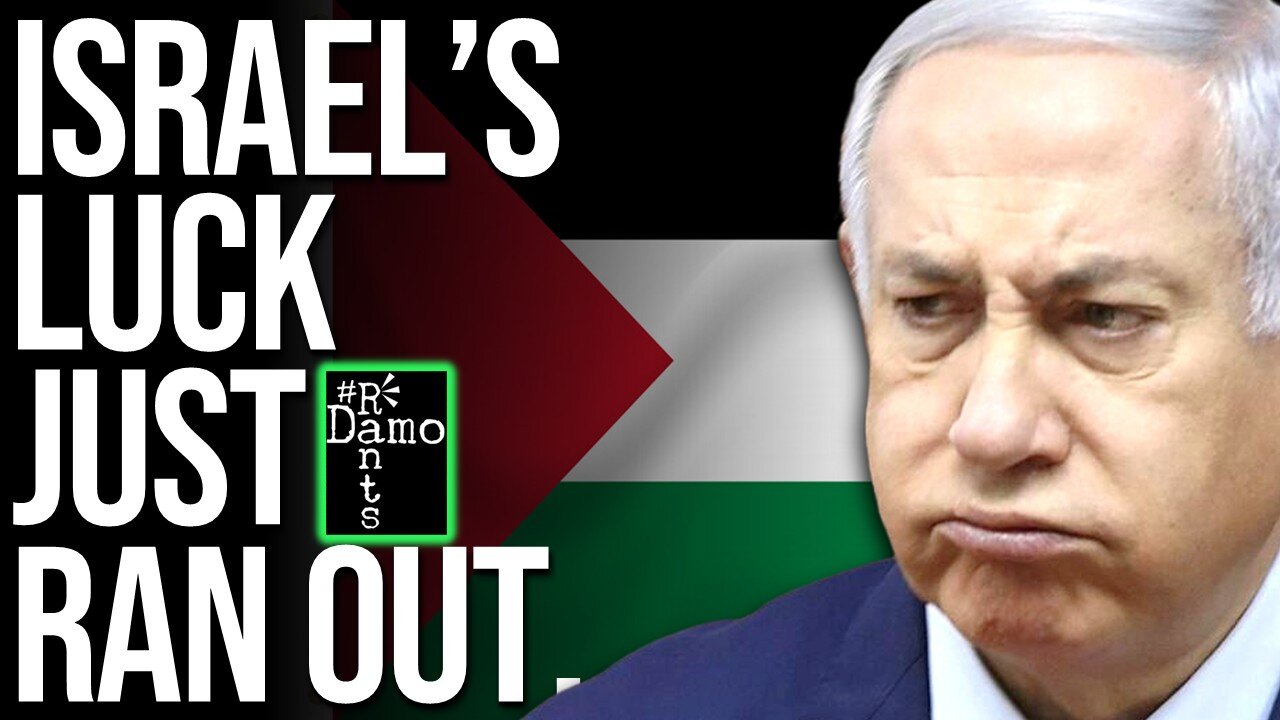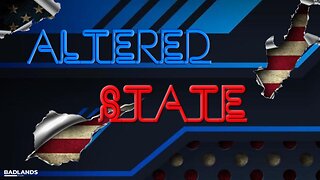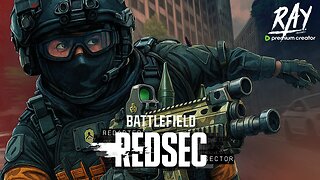Premium Only Content

Israel's Gaza 'Ceasefire' Has Been Exposed As a Sham — And Now They're Cornered
Right, so they told us the ceasefire was the turning point. Food would flow, families would go home, and Gaza could start breathing again. But the moment the bombing slowed, it never stopped, the truth soon became clear. Only 986 aid trucks were allowed in. People returning to their own front doors were still met with lethal force. A new boundary was marked inside Gaza, and civilians were kept out of their own neighbourhoods. Ministers in Tel Aviv spent the ceasefire threatening to bring down their own government unless Palestinians were executed. The United States set up a command centre to oversee Israel’s behaviour because even Washington didn’t trust them not to break their own deal.
So no — the ceasefire didn’t stop the violence.
It just made it easier to see who was causing it, how it works, and why they needed the bombs in the first place and Israel, still in the spotlight over this, are in meltdown over it. Well boo hoo.
Right, so they told you the ceasefire meant relief. They told you it meant food reaching people again. They told you it meant families going home, aid trucks flowing, civilians finally able to breathe. That was the public story. And almost immediately, that story fell apart. Because when the airstrikes slowed, the dying did not stop. The hunger did not stop. The displacement did not reverse. What changed was not the reality on the ground, but the ability to see it more clearly. The ceasefire did not end the violence. It removed the noise that had been masking it.
From the first days of the ceasefire, Gaza’s Government Media Office reported that only 986 aid trucks had entered the Strip. They described this as far below what Israel had agreed to, 600 a day, more than 6000 should have passed through. They also stated publicly that the occupation was using aid as leverage. That is not speculation. That is the language used by the authorities responsible for tracking the delivery of supplies. When a ceasefire is in place and the blockade mechanisms remain, the message is unambiguous. The deprivation was not an emergency measure attached to bombardment. The deprivation is structural, its been designed that way.
When people in Gaza attempted to return to their neighbourhoods, to check the remains of their homes, to retrieve belongings or simply confirm whether they still had a place to return to, they faced lethal risk. The case of Mu’ath Abu Rokbah, reported as the only vet in northern Gaza, is an example that demonstrates the conditions. He was killed after going to inspect his home. The ceasefire did not create safe civilian movement. It did not allow people to return. It did not reestablish the basic function of civilian life. It froze the violence in place and continued it through access and permission rather than explosives.
At the same time, Israeli forces marked and enforced what was reported as a new boundary inside Gaza: the Yellow Line. I spoke about this the other day, apparently marked by concrete cubes painted yellow yet they are apparently not everywhere. This was not the border though. It was a line drawn inside the Strip. Civilians in areas along that line were cleared and prevented from returning, anyone unknowingly crossing got shot. The ceasefire did not restore territory to Palestinians. It reorganised the terms under which the territory was controlled. Palestinians get penned in to a smaller and smaller concentration camp than they were already in and Israel still resolutely occupies the remainder, Part two of the Trump peace plan being avoided like the plague, because that requires full withdrawal, which Netanyahu wouldn’t politically survive. The reporting also stated that internal discussions occurred within the Israeli government over how aggressively to enforce this arbitrary perimeter of theirs. The fact that such a discussion occurred shows that the ceasefire did not end the possibility of lethal force. It simply changed where and how that force would be applied.
Therefore the ceasefire has not restored mobility, agency, or safety. It revealed that those things had not existed before the ceasefire either. When the airstrikes were ongoing, the cause of the harm could be described as the bombs. When the airstrikes eased, the cause of the harm could no longer be attributed just to the explosions. The blockade, the displacement, the hunger, the restricted movement remained. That is what exposure looks like and Israel hates it, it hates this ceasefire because this is what it does.
During this same period, internal instability within the Israeli government became visible. National Security Minister Itamar Ben-Gvir publicly threatened to withdraw his party’s support from the governing coalition unless legislation imposing the death penalty for Palestinian prisoners was advanced, prisoners he’d once again intentionally visited to taunt them over his death penalty plans. He is obscene even by Israeli standards. This was not back-room pressure. It was a stated ultimatum, he has so much clout he brags about it. The government’s survival depends on maintaining the support of the far-right factions, like his, making that demand. So it is a matter of parliamentary arithmetic that we know this ceasefire won’t go further.
At the same time, National Security Adviser Tzachi Hanegbi was removed after calling for an investigation into what he described as the failures preceding October 7. His departure was loudly announced, God forbid Israel allow any investigation into the events of that night, why do they resist it if they are so righteous over it? Eyewitness reports of Israeli tanks and gunships striking Israeli citizens in the kibbutzim and the Nova Music Festival, together with admissions of use of the Hannibal Directive from former Defence Minister Yoav Gallant mean we already know it wasn’t just Hamas shooting at Israeli citizens that night. The more Israel resist that investigation, the guiltier they look. The timing of all of this matters. A ceasefire is the moment when a state with secure legitimacy would investigate its own decisions. Here, the request for inquiry led to the removal of a senior figure. This is not the behaviour of a confident administration. It is the behaviour of one that cannot tolerate scrutiny and it seems pretty obvious as to why that is.
The ceasefire also has not stabilised Israel’s diplomatic standing. In the last few days, Finance Minister Bezalel Smotrich rejected the idea of normalisation with Saudi Arabia if it required recognising a Palestinian state. He used dismissive language toward Saudi Arabia while doing so, he told them to stick to riding their camels in the desert. The remark drew international reaction. He then issued an apology for the phrasing, but not the position itself. The policy remained. The message was clear. The Israeli government was not using the ceasefire to open political space for negotiated settlement. It was using the ceasefire to reassert its refusal to recognise Palestinian sovereignty, even at the expense potentially – certainly for the far right – of normalisation with Saudi Arabia which Netanyahu covets so much.
Inside Gaza, the ceasefire revealed struggles over authority that had been obscured during bombardment. Reports described Hamas preparing what was referred to as its largest campaign yet to dismantle armed groups collaborating with and armed by Israel. One of these groups, the Al-Shabab gang in Rafah, was reported to have an estimated two thousand fighters. The reporting included statements that captured members had confessed to carrying out kidnappings and attacks. Whether every detail of those claims is accurate is not the point here. The point is that the ceasefire did not bring internal demobilisation. It brought internal consolidation. The struggle for control has not stopped. It simply moved into a different phase.
During this same period, representatives from Palestinian factions met in Cairo and issued a statement opposing annexation and displacement and calling for national dialogue. This shows that political coordination is occurring. It does not imply unity. It shows intent to prevent fragmentation, but good luck with that when Netanyahu’s future depends on exactly that.
Meanwhile, the United States did not merely comment on the ceasefire. It took an administrative role in its implementation. An Israeli-American representative, Michael Eisenberg, was appointed to liaise with a US military coordination centre managing ceasefire logistics from inside Israel. Eisenberg has two sons serving in the Israeli military and was allegedly one of the masterminds behind the Gaza Humanitarian Foundation and the aid camps with became death traps for so many in Gaza. Yet again, the appointment of a non-neutral partner to oversee something where independence is essential, but its never the point is it? The US moans at Netanyahu for undermining the ceasefire, but they are doing it as well. To prove that point, US officials also conveyed concern that Israeli government decisions could jeopardise the ceasefire, look in the mirror will you?
This reveals the central problem though. Israel is not operating alone. The administration of the ceasefire is being managed with US involvement and they aren’t helping matters. The United States is not acting as a brake on Israeli policy. Its role inside the ceasefire structure is to keep the system functioning. The coordination centre established in southern Israel does not exist to protect Palestinians. It exists to maintain the political and military arrangement that keeps Gaza under control. Oversight here does not mean restraint. It means integration. When Washington intervenes, it is to prevent disruption to the management of the siege, not to end it.
This is the real exposure. Israel is not acting alone, and it is not acting in opposition to US power. It is acting inside a framework built with US power. The ceasefire did not show Israel losing control. It showed that the control itself relies on external backing. The blockade, the restricted aid, the defined kill-zones, the internal displacement lines — these continue with American involvement, not in spite of it.
The violence did not pause.
It was administratively stabilised.
Gaza is not being governed. Gaza is being managed. Managed through controlled scarcity. Managed through enforced displacement. Managed through external oversight. Managed through the prevention of return. Managed through the regulation of who may live where, with what, and under which conditions.
The lack of bombardment did not loosen the blockade. It made the blockade visible as the primary tool. When food is allowed in only in restricted quantities, starvation is not a side effect. It is an outcome produced by administrative choice. When civilians cannot safely return to their homes even during a ceasefire, displacement is not temporary. It is institutional. When a boundary is drawn inside the territory and enforced with armed force, territorial reduction is not an accident of war. It is a policy.
The Yellow Line functions as evidence. It is not rhetoric. It is not metaphor. It is an enforced boundary inside Gaza, backed by military presence, represented by painted concrete cubes where Israel have laid them at least, which residents were removed from and prevented from re-entering. The ceasefire was the moment in which this could be documented, because the absence of airstrikes made it clear that the line was not about immediate battlefield conditions. It was about redefining the physical terms of occupation.
The siege on aid functions the same way. When the Gaza Government Media Office reports that only 986 trucks have entered thusfar during the ceasefire and states that Israel imposed conditions on access, the meaning is direct. Humanitarian access is not being obstructed by active fighting. It is being obstructed by permit, approval, and control systems that continue regardless of whether bombs are falling or not. It’s another form of siege that just carries on. The ceasefire removed the last possible justification that starvation was the result of wartime logistics. The starvation continues. The cause is therefore administrative.
The killing of civilians attempting to return to their homes under ceasefire conditions shows the same thing. Movement remains dangerous not because of explosions but because of enforcement. If a ceasefire does not permit a civilian to walk to their home without risk of death, the ceasefire is not a neutral pause. It is just a reorganisation of the violence.
The political instability inside Israel is part of the same picture. A government that cannot pursue investigation into October 7 without removing the official requesting it is not stable. A coalition that can be threatened into legislative action by a single faction is not secure. A leadership that cannot tolerate internal review during a ceasefire is not confident in its position. The ceasefire exposes this instability because wartime unity narratives could no longer drown it out. When the bombardment slowed, the political fractures returned to the surface.
The diplomatic dispute triggered by Smotrich’s remarks demonstrates something similar. The government did not use the ceasefire to seek regional alignment or diplomatic stability. It used it to reassert its refusal to recognize Palestinian sovereignty, even when speaking to a regional power with whom normalisation had been a stated strategic goal. The wording was walked back. The position remains the same. Diplomatically, this is not a government preparing for reconciliation or transition. It is a government committing itself to permanent control.
Inside Gaza, the ceasefire allowed internal armed competition to become visible. The reports describing Hamas preparing to dismantle armed groups who are collaborating with and been armed by Israel show that the ceasefire is not creating a unified governance environment. It is creating space for the dominant faction to assert control over the territory. The alleged size of the Abu Shabab group — around two thousand fighters — indicates that this is not a minor security matter. The reports that captured members confessed to attacks and coordination with Israeli forces are claims made by the authorities conducting the arrests. They demonstrate the framing of the conflict, not necessarily the full truth of each case. But the scale of the planned operation demonstrates that Gaza’s post-war governance is being actively contested under ceasefire conditions. The ceasefire did not end the conflict. It shifted where the conflict occurs.
The meeting of Palestinian factions in Cairo shows political organisation on the Palestinian side. The rejection of annexation and displacement shows that there is an articulated political position against the territorial reconfiguration taking place under ceasefire enforcement. This is not the absence of agency. It is the presence of strategic calculation. The ceasefire period is being used to negotiate internal political direction and maintain claims to territory and sovereignty.
The involvement of the United States in administering the ceasefire does not signal restraint. It signals standardisation. The coordination centre in southern Israel is where the logistics of the ceasefire are processed — aid authorisations, movement permissions, and communication between Israeli command and foreign governments. When Michael Eisenberg was appointed as Israel’s representative to that centre, as I mentioned a moment ago, it confirmed that ceasefire implementation runs through a shared infrastructure. The United States is not there to protect civilians. It is there to ensure that the blockade, displacement controls, and territorial enforcement continue without collapsing into diplomatic crisis.
This is not a hierarchy. It is a joint operating structure. Israel controls the territory. The United States ensures the arrangement remains politically sustainable. The ceasefire makes the arrangement legible. The violence does not pause. The violence becomes orderly.
And once exposed, the system cannot be mistaken for anything else.
When bombardment stops and the violence continues anyway, you are forced to look at what is actually doing the killing. During the ceasefire, the explosives stopped being the main instrument. The system itself emerged as the mechanism of harm. That is the exposure. The harm in Gaza is not episodic. It is not tied to military exchanges. It is built into the architecture of control.
There is the controlled entry of aid. When the number of trucks entering is low enough that families remain hungry, the blockade is not incidental. It is deliberate administration. Permission determines whether people eat. Permission determines whether medicine enters. Permission determines whether water is clean or contaminated. When the ceasefire begins and the permissions do not change, the siege is not a wartime measure. It is the constant condition.
There is the enforcement of displacement. When civilians are removed from areas inside Gaza and not allowed to return, even after the airstrikes slow, displacement is not an accidental outcome of conflict. It is an ongoing policy. The Yellow Line shows this clearly. It is a border imposed inside a border, enforced with military threat during a ceasefire. That is not temporary security. It is territorial reduction.
There is the risk attached to movement. When civilians are killed while returning to homes during a ceasefire, the ceasefire does not guarantee safety. It imposes a new pattern of danger. The threat moves from above to in front. This is still coercion. It is simply quieter.
There is the condition of governance. When a government removes an adviser for calling for accountability during a ceasefire, the ceasefire does not create stability. It reveals the absence of stability. The unity of wartime rhetoric dissolves, and the structure underneath is exposed. The coalition holds together only through concessions to its most extreme faction. It is held in place by dependency. When the pressure of constant bombardment is removed, the political tension is no longer masked. It is the baseline.
There is the diplomatic posture. When a senior minister publicly rejects normalisation if it requires recognising Palestinian statehood, and the state stands by the position even after apologising for the wording, it is clear that the ceasefire is not part of a negotiation toward two states or shared sovereignty. The state is not preparing for coexistence. It is maintaining a doctrine of permanent control.
There is the internal contest in Gaza. When one faction prepares to dismantle armed groups alleged to have worked with the occupation, the ceasefire is not a transition to calm. It is a transition to internal consolidation. The struggle for governance did not stop. It moved into a phase where it is not being obscured by active bombardment.
There is the role of the United States. When a US run coordination centre oversees the implementation of a ceasefire and diplomatic pressure is applied to maintain it, the relationship between Israel and the United States becomes clear. Israel is not acting independently. The United States is not simply supporting Israel. The United States is managing Israel. The ceasefire exposed as a hierarchy of siege.
Once all these elements are seen together, the narrative that the ceasefire represented relief cannot be sustained. The ceasefire did not introduce a new condition. It made the existing condition visible. Gaza was already being controlled through blockade, displacement, restricted movement, and enforced dependency. The ceasefire simply removed the distraction of constant explosive violence so that the underlying control could be observed directly.
This is why the starvation has not stopped. This is why families cannot return home. This is why hospitals are still struggling. This is why reconstruction cannot begin. This is why political instability in Israel intensified instead of easing. This is why Palestinian factions were able to organise. This is why the diplomatic position hardened instead of moderating. The ceasefire revealed the operating system.
The operating system is structural violence.
The operating system is control through deprivation.
The operating system is territorial reduction enforced under ceasefire.
The operating system is governance dependent on coercion.
The operating system is sovereignty denied.
The ceasefire did not strengthen Israel’s position, nothing has changed there.
It revealed how dependent that position is on blockade, displacement, and external management though.
The ceasefire did not weaken Palestinian claims to sovereignty.
It showed that those claims persist even under siege.
The ceasefire has not stabilised the region.
It made visible that stability was never the goal.
This is not a ceasefire that pauses conflict.
It is a ceasefire that clarifies the conflict.
The violence did not end when the bombs stopped, not that they have actually stopped, merely slowed.
Only the noise did.
Where things may not have changed meaningfully as far as the ongoing sham of a ceasefire goes, legally things have shifted somewhat as bad news for Netanyahu has continued to stack up, not least of which as the ICJ just tore away his last legal defence at the world court, so check out the details of that story in this video recommendation here as your suggested next watch.
Please do also hit like, share and subscribe if you haven’t done so already so as to ensure you don’t miss out on all new daily content as well as spreading the word and helping to support the channel at the same time which is very much appreciated, holding power to account for ordinary working class people and I will hopefully catch you on the next vid. Cheers folks.
-
 LIVE
LIVE
Badlands Media
5 hours agoDevolution Power Hour Ep. 402
12,847 watching -
 LIVE
LIVE
Inverted World Live
4 hours agoUFO Seen Over Tokyo During Trump Visit | Ep. 132
3,586 watching -
 LIVE
LIVE
TimcastIRL
3 hours agoDemocrat FEDERALLY INDICTED For Obstructing ICE Agents In Chicago | Timcast IRL
7,216 watching -
 LIVE
LIVE
SpartakusLIVE
4 hours agoNEW - REDSEC Battle Royale || The Duke of Nuke CONQUERS ALL
217 watching -
 LIVE
LIVE
PandaSub2000
1 day agoLIVE 10:30pm ET | NINTENDO DS Night
102 watching -
 LIVE
LIVE
Alex Zedra
1 hour agoLIVE! Battlefield RecSec
244 watching -
 1:26:50
1:26:50
The Quartering
3 hours agoErika Kirk Threatened, SNAP Riots Near, & New AstroTurfed Woke Lib Influencer
19.6K10 -
 29:24
29:24
Glenn Greenwald
4 hours agoSen. Rand Paul on Venezuela Regime Change, the New War on Drugs, MAGA Rifts, and Attacks from Trump | SYSTEM UPDATE #539
89.6K79 -
 DVR
DVR
Badlands Media
16 hours agoAltered State S4 Ep. 3
25.4K14 -
 LIVE
LIVE
This is the Ray Gaming
53 minutes agoRedacted Sector Day 2 | Rumble Premium Creator
48 watching